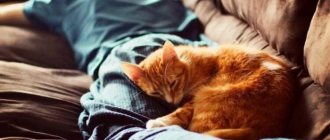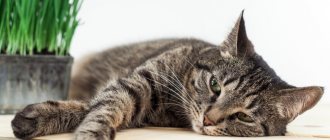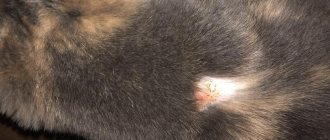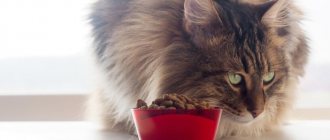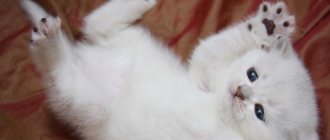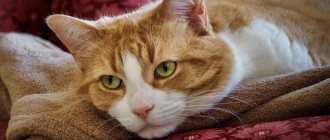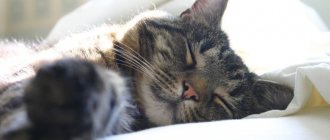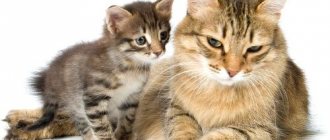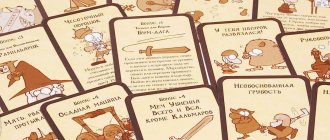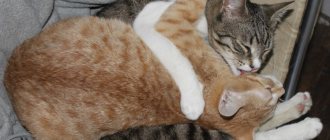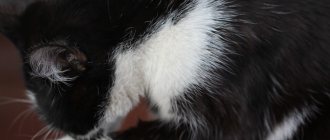When you see your cat fall to the ground and roll onto its back, your pet's posture can tell you something. Sometimes this is accompanied by rubbing the head on the floor while meowing. Your cat may be itching a lot or just wanting a good exercise, but this movement is often a positive signal for your cat. Rolling over usually signals that the cat feels secure and may want your attention.
Safety and security
A cat doesn't roll over onto its back if it doesn't feel safe. In fact, the cat rolls over onto its back in its most relaxed state. Think of it as cat zen mode. If a cat rolls over in front of you, this is a good sign. This is your cat's way of saying, "I trust you." Exposing the belly and/or sensitive parts is a very vulnerable moment for your cat and gives you both an opportunity to bond.
Sleeping on your back: normal or pathological?
The instincts, behavior and habits of cats are in many ways similar to human ones. This applies not only to reactions and needs inherent in nature, but also to banal physical states: relaxation, tension, etc. During rest, a person can lie on his back, stomach, side, or in the fetal position. This is often due to the level of fatigue, mood, or a banal habit.
In their dreams, cats encounter different emotionally charged episodes.
Curious! Scientists conducted a number of experiments studying animals during sleep, in particular cats were experimental subjects. It turned out that they, like people, are no strangers to emotional dreams. Moreover, it was possible to decipher their contents. Mostly these are episodes of hunting, exploring the area, irritation and even fear.
They say that a cat sleeping on its back sees only good dreams.
Human and cat rest are similar in that during this time both are capable of experiencing happiness. For cats, one of the indicators of this condition is sleeping on their back. This body position is absolutely normal. There is no need to worry about the health of a kitten seen lying on its back with half-closed eyes.
Cat looking for attention
Consider the time, place and circumstances under which your cat might roll onto its back. For example, if your cat rolls over in front of you every morning as you get ready for the day, it's a sign that she needs attention. Spend some time with your cat if you see him rolling on your back, your legs, or the floor.
Giving your cat this kind of attention "pays" the cat to roll - it is a positive reinforcement of the cat's behavior. This way, your cat will repeat the rolling motion again the next time more attention is needed. Cats love routine, so once you've established a pattern, rolling becomes a calming ritual.
Why does a cat roll in the dust?
It has been noticed more than once that in warm summer weather cats love to roll around outside in the dry dust. Domestic cats are regularly caught in the fact that when they enter the entrance, the first thing they do is begin to lie on the dusty concrete floor. Looking at their behavior, one can only be perplexed, since these animals generally have a passion for cleanliness, but certainly not for dust. One might assume that such wallowing gives them pleasure, but after this the cat will have to spend quite a lot of time to wash off all the dirt, and even if it is lying around for pleasure, then why not do it in a clean place? Agree that this is not very similar to ordinary self-massage or gymnastics. Then maybe they do this so that their fur coat will absorb the smells of the street?
Cat Behavior Marking
Rolling on the ground can spread cat odor. Since cats primarily communicate through the scent of someone or something, they use their scent glands on their cheeks, paws, and sides to give them a personal scent. This behavior is observed in both domestic and large cats.
When your cat rubs its head and cheeks on the floor, it can leave its scent marks on the house and on your feet. This tells the other cats that they were there, took their place and have already marked you (so the other cats need to retreat). Marking is used as a way to keep potential enemies or rivals away.
Many cats instinctively want to mark their territory through rubbing and scratching. However, if your cat is marking its territory with urine, you will need to teach it to stop.
Features of cat sleep
Every average nine-year-old cat slept for at least six years! However, “overslept” is a rough definition, more like dozed off. Cats allow themselves sound, healthy sleep much less often; they spend most of their lives in the relaxation stage.
Video - How and where cats prefer to sleep
Sleep phases
Table 1. Physiological changes in different stages of sleep
| Criterion | Slow phase | Fast phase |
| Heart | Reducing heart beats | Increased heart rate, pulse may be uneven |
| Lungs | Slowing down your breathing rate | Breathing rate is variable |
| Muscles | Muscle relaxation | Convulsive movements of the tail, paws, twitching of the ears |
| Eyes | Slow fading eye movements occur under the eyelids | Rapid eye movement |
| Body temperature | Decreases (to several degrees) | Increasing |
| Arterial pressure | Decreases | Increasing |
During half-sleep, pets do not cut off contact with the outside world, but continue to receive a continuous stream of information about what is happening around them. This feature is reflected in the position they choose to rest. If we take a closer look at the position of the entire body, we will notice that in most cases the animal takes a “on the alert” position. This means that if an irritant appears, the cat is ready to jump up sharply, and then either run away or attack.
Behind the cat's apparent relaxation, combat readiness is sometimes hidden.
Light, short sleep helps predators quickly regain strength for a short period of time to do intense work before the next period of slumber.
It is impossible to stay on constant “recharging”, so cats plunge into a healthy and sound sleep at a certain moment for the full restoration of the entire body, in particular the immune system. In this case, cats do not immediately wake up in full mobilization of strength.
A cat may unexpectedly end up on its back while sleeping
You can tell that the cat didn’t just close his eyes for five minutes, but fell asleep fully by his posture. It happens that a cat falls asleep in a half-curled position, but over time it begins to toss and turn and ends up on its back, with its paws tucked or spread out. Lying with his eyes closed in this position, the cat is not just dozing - he is completely relaxed and immersed in deep sleep, being completely indifferent to external stimuli.
Mating and catnip
If you've ever given your cat catnip, you may have noticed this rolling behavior. Catnip herb usually incites a strong reaction in cats. Its active compound nepetalactone is a powerful aroma that awakens a cat's sexual desires. This is what makes them roll on the ground after inhaling.
You will also find that many cats roll around and rub against objects during heat or after mating. This is probably due to hormones and ovulation. Any frantic movements could also mean that your cat is trying to get rid of the cat's scent before moving on to another cat.
Rolling on the floor as an expression of playfulness
Of particular note is the tendency of cats to roll around near their owner’s feet. As a rule, this happens when the owner is busy with some business. In this case, the cat wants to attract his attention and hints that the owner should drop everything and pet her or play with her. In other words, this is a manifestation of playfulness and desire for contact. When the owner is constantly busy with something, and the cat is forced to spend all the time alone, she is sometimes forced to deliberately attract the attention of her owner. In this case, you should really take a break from your affairs and devote at least a minute or two to your pet. However, you should warn in advance that cats are crafty creatures and, exposing its belly to the owner and inviting the owner to pat it, the cat will immediately grab his hand with its claws.
Cats are not as submissive as dogs
Many dogs roll over onto their back as a sign of respect or submission, unlike cats. When cats roll over, it is usually an invitation for attention rather than submission. If you have another animal in the house, such as a dog, your cat may roll back when the other pet isn't around to let you know it needs some love.
Never assume that your cat is asking for a tummy rub like dogs do when they roll over. Otherwise, your hand may be grabbed and forced into submission. Most cats love scratches behind the ears, so it's best to start there.
Dust as a means of camouflage
Cats living in the wild are forced to provide their own food, and their prey also has some intelligence. But besides this, she also has a fairly developed sense of smell, thanks to which she can sense the presence or approach of a hunter. To get rid of this, on the one hand, the cat constantly licks itself to minimize its natural aromas, and on the other hand, it tries to mask them by rolling out in the dust. Even if the smell of a cat seeps through the smell of dust, it will be little distinguishable from the smell of ordinary cat tracks left on a dusty path, which can dull the vigilance of potential prey, which cats successfully use. And although in urban environments there is no need for camouflage, the habit turns out to be second nature not only for humans, and cats continue to wallow in the dust, as if they were still living somewhere in arid Africa and tracking down local small rodents.
Limitless possibilities
There may be other reasons why your cat rolls on the ground. Because cats have a higher body temperature, they are more likely to sunbathe or sleep near a heater. Because of this, cats can easily experience this sensation and need to cool down. This includes drinking plenty of water, resting in cool places, and rubbing yourself on cool floors. Your cat can also protect its digestive system by rolling around in the dirt, coating its fur with bacteria and ingesting it by licking its fur. Whatever your cat is doing, there's probably a good reason for it.
Common Causes
Lying on the floor, the cat strokes and scratches its back , which is accompanied by physical pleasure and relaxation. So, the most common reason for riding on your back is the desire for comfort. Don't worry about not getting enough attention; cats always strive for maximum comfort and can roll around on the floor simply because it feels good. If the behavior becomes too regular, perhaps the reason is self-soothing, that is, this is how the cat deals with stress.
Adult cats prefer a sedate lifestyle, but even the laziest four-legged cats are active for 15–20 minutes at a time. Riding on your back is an excellent warm-up for the muscles of the back and neck, which, by the way, almost never relax in cats.
While rolling on its back, your cat can brush its fur , especially if you have a long-haired pet. The fact is that when four-legged animals lick themselves, the hooks on the tongue catch the hairs, and the cat swallows them. If the fur coat is very fluffy, the tailed one has to swallow a lot of fur, which can lead to intestinal blockage ... and, in principle, not very pleasant. Usually, for combing, the cat chooses rough surfaces: carpets, sofas, rugs near doors.
Normal itching in the back area can make the patient roll on the floor. The fact is that the cat cannot scratch certain areas of the back with its paws and is looking for other methods. Sometimes, pets show their owners their backs and demand to be stroked/scratched. There is nothing strange about this behavior as long as the cat is not in obvious discomfort.
You should be wary if your pet itches too much. Perhaps the animal is suffering from fleas or other blood-sucking parasites. If you notice disturbing behavior, be sure to take preventive measures and observe changes. If your cat continues to itch, consult a doctor.
The likelihood of fungal infection is very high, even if the cat does not go outside. The problem is that without laboratory analysis of skin scrapings, it is very difficult to guess the treatment. The range of possible diagnoses and pathogens is so wide that veterinarians sometimes act at random.
Note! If a cat is found to have parasites or fungi, it is prescribed antihistamines to partially eliminate the itching.
The mechanism of purring in cats
Zoologists studying the process of purring put forward three hypotheses regarding the mechanism of rumbling:
- Cats purr using false vocal cords;
- Rumbling occurs due to air vibrations in the sinuses;
- Rumbling occurs in the lungs when air is exhaled.
The vocal cord hypothesis suggests that when a cat opens its mouth, it makes a meow, and when its mouth is closed, air vibrates in the larynx and creates a purr.
Other experts believe that when a cat experiences positive emotions, its blood pressure increases. Due to this, vibration appears in the chest and is transmitted to the sinuses, resulting in purring.
Still others believe that the rumbling is generated by the vibration of the intercostal and diaphragmatic muscles during inhalation and exhalation. Which part of the feline brain is responsible for purring is still unknown.
A similar sign
It happens that a cat comes into the house as an uninvited guest. Most people are ambivalent about this. After all, an animal has a lot of reasons to enter a specific apartment or someone specific; its appearance is not accidental. It depends only on the person what to do with an animal that suddenly appears on the doorstep: drive away or shelter, feed and caress.
Most often, a cat comes to the doorstep to protect the house and its inhabitants from danger, to protect them from evil. The attitude towards her can affect the course of affairs in the near future. A person who drives out or offends an animal risks angering higher powers and bringing disaster upon himself. To the one who lets him in, the cat will bring peace, prosperity and prosperity into the house.
Coat color meaning
The color of a stray cat is of fundamental importance and carries information about the purpose of its appearance.
White
Attracts wealth and prosperity to the home. Symbolizes health and vital energy, if it appeared during a period of illness, recovery will not take long.
Black
Brings success in business, good luck in any endeavor, joy and good news. Psychics believe that a black cat protects its owners from otherworldly entities, negativity, the evil eye and damage.
Redhead
Its appearance promises career advancement, a solution to material problems, and a change for the better in one’s personal life. In addition, the ginger cat drives people away from home who want evil and “attracts” good people.
Gray and blue
A symbol of good luck, happiness in your personal life, joy and harmony with your inner world. According to custom, brides in Thailand are given a blue kitten as a sign of love and tenderness. The strong point of such a cat is the treatment of diseases. It is believed that the gray animal has mystical abilities on a par with the black one.
Tricolor
It means the approach of happiness and good luck, as well as unexpected profits. White color has a beneficial effect on health, red color brings prosperity to the family, black color repels evil spirits.
On our website you can also read an article about signs about tricolor cats.
Four-color
A hunter of happiness and good luck, she brings them to the home and family.
Pregnant
A harbinger of an imminent addition to the family. If a cat gives birth to black and red kittens, they keep the black one for good luck and happiness.
Deceased (comes in a dream)
If you dreamed of a living dead cat, according to the dream book, a person causing psychological discomfort will pass away. A dream can also be a signal of impending danger, a warning from a pet.
If a kitten gets lost
A kitten that has found its way to the house can mean an imminent addition to the family. When people have been trying for a long time and unsuccessfully to conceive a child, a long-awaited dream comes true with the arrival of a furry guest. By letting in a homeless child, future parents make it clear that they are ready to take care of their offspring.
In case of illness, the kitten will also play a positive role. On the one hand, it will distract the patient from painful thoughts, on the other hand, according to signs, the cat was sent by higher powers to ward off illness, and possibly death.
The appearance of a kitten in a house where a person has recently died symbolizes news from the deceased, makes it possible in a tragic situation to be distracted by the baby, and it is easier to cope with the loss. By driving him away, a person risks angering the inhabitants of the other world and bringing upon himself troubles and misfortunes.
Peaceful emotions
Domestic cats most often expose their bellies when they are in a good mood.
Signs about death
Many signs are associated with cats and death. Here are the most common:
- the cat is lying on the table - at worst, it is “staying after” one of the household members;
- lies under the bed or does not leave the side of a seriously ill person, then he will soon die;
- if a cat shits on the clothes of a person with a cold, it means a speedy recovery;
- if a cat lies down at the feet of a patient - to recovery, if it leaves him - he will soon end up in the grave;
- if a cat sleeps in a person’s head, this indicates that the latter will soon end up in a cemetery, since the animal “drives” him out of the house;
- if a cat suddenly begins to meow loudly and for a long time, this means the death of one of the household members; the animal is trying to ward off death with screams.
Scent marks
Sometimes cats ride on their backs, marking territory or things with their personal scent. At the same time, they grumble, “trample” their paws, releasing their claws, and rub their cheeks, on which special secretory glands are located.
A cat can similarly “appropriate” a person or mark his things, for example, by lying belly up in a laundry basket.
This is how the mustachioed striped animals try to drown out foreign odors that were collected outside the house and remained on the skin and fabric.
Demonstration of trust
A satisfied and calm cat in its territory playfully rolls from side to side, gracefully stretches out and squints its eyes. At the same time, her muzzle radiates bliss and serenity - this is how an animal invites a familiar person to careful caresses and gentle stroking.
A sign of friendship and goodwill towards a person or fellow tribesman for a cat lying on its back is the stretching of its front paws with soft pads.
In small kittens, riding on their back often symbolizes a call for active games that copy elements of protective behavior. By “fighting” with brothers and sisters for fun, the baby develops muscles and learns to control his body. A kitten inviting you to play will quietly meow or purr, and, in defense, it will snort and hiss.
Interpretation by month
When trying to understand what a cat coming into your house or yard promises, you should pay attention to the month in which the guest arrived.
January
The cat comes to people who are mired in loneliness, helps them find warmth and find a soul mate.
February
The animal symbolizes the desire for change. Having sheltered it, a person will want to radically change his life, interior or image.
A stray cat brings love and passion to life. Lonely people will meet their fate, established relationships will flare up in bright colors with renewed vigor.
April
In the midst of spring, the cat will give fresh strength and energy. To the person who lets it into the house, the animal promises success in work and study; an active lifestyle will take career and relationships to a new level.
The guest takes care of well-being, warns about possible theft or robbery, protects against thoughtless spending and unsuccessful investments.
A cat helps you relax mentally and physically, restore strength, and wards off unpleasant people.
Appearing at the height of summer, the tramp brings comfort to life and to the apartment, has a beneficial effect on the energy of things, and heals the body and soul of its new owners.
August
The cat protects the house from dark forces, preserves health and material well-being.
September
The animal that comes with autumn protects from a negative environment and bad thoughts. It brings the need for cleansing, getting rid of unnecessary things and bad mood.
October
The cat protects the family from danger and warns of the need to reconsider the immediate environment.
November
The appearance of an uninvited guest indicates possible problems in your personal life, the likelihood of a love spell or seduction.
December
The arrival of a cat indicates the need to protect the family from government officials or organized groups.
Mr. Cat recommends: the most popular signs
One of the most famous beliefs is that a cat should be the first to cross the threshold of a new home. She will “assess” the energy state of the new home and establish contact with the brownie.
Here are the most common and often true signs associated with cats:
- the cat broke the mirror - fortunately;
- washes his face - to the guests;
- petting a cat if he comes up on his own means good luck and material well-being for the near future;
- There must always be at least one cat on the ship, then it will return safely to the port (the wives of sailors kept black cats in the house so that their husbands would definitely return);
- whoever pours water on a cat loses half his life;
- kittens cannot be given away for free; you must take at least a small coin in return;
- by feeding stray cats, a person patches up his karma, and also ensures a prosperous afterlife existence for deceased relatives;
- Taking home a stray cat and taking care of it will bring money and happiness; driving away an incoming animal will incur punishment from higher powers (it is believed that cats only come to places where they are really needed).
Cats have been living next to humans for a very long time, bringing joy with their mere presence. It turns out that they can bring quite material well-being, as well as protect the house from troubles and ward off death. Therefore, you need to protect and care for your furry pet so as not to incur the wrath of the goddess Bast and her comrades from other mythological stories.
